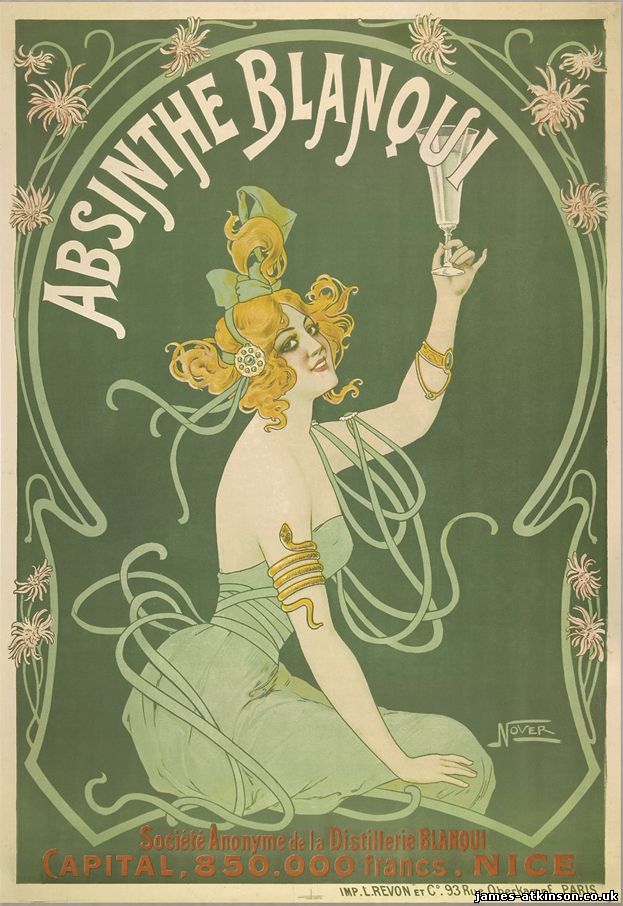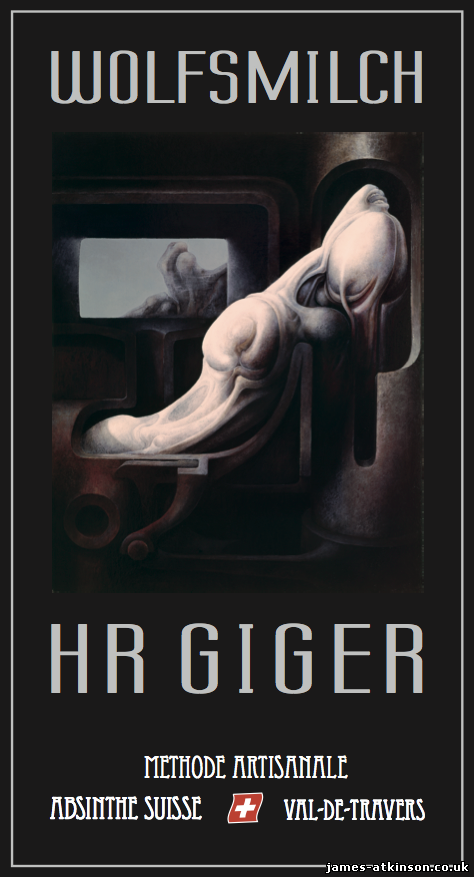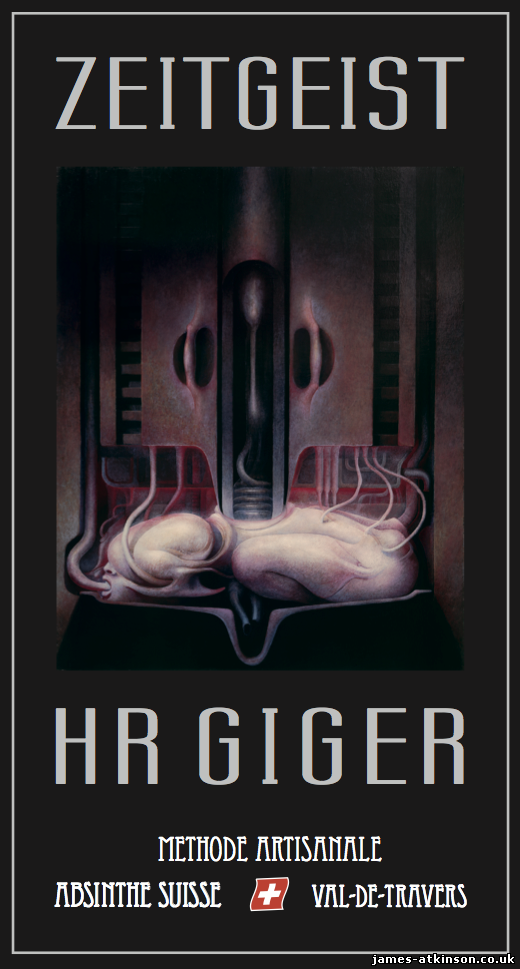0:30 AM Absinthe makes the heart grow fonder as the green fairy tickles our taste buds |
Before I continue with this blog I want to make it clear that alcohol should be taken in moderation and responsibly. This is especially true for high percentage spirit where it may still be in your system the morning after.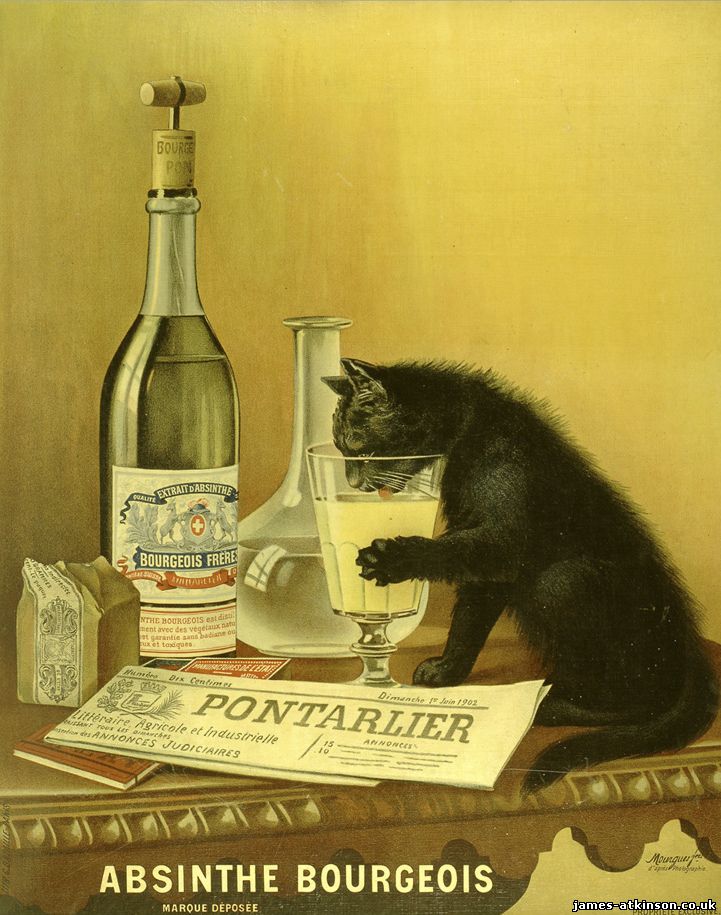 One of the most famous depictions of absinthe dates from 1900
Designed by the Mourgue brothers for the Bourgeois distillery in Ponterlier
Absinthe has the most interesting history of any spirit. It was banned in a few countries and then made a remarkable comeback. It has inspired the great and good of art and also sent people into delirium. Lets travel on a brief history of absinthe and then prepare a glass. 200 years ago within the Jura Mountains of France and Switzerland the drink began it’s life near Couvet and neighbouring Pontarlier in the Doubs region of France. Pontarlier is still classed as the spiritual home of absinthe. In 1795 Dr Pierre Ordinaire allegedly created the receipt for medicinal purposes. He used local herbs to design a drink that would cure gout, epilepsy and other such ills. These herbs included fennel, roman and local wormwood. The reputation of this drink was to spread far and wide. It reached Major Henri Daniel Dubied who purchased the receipt at the beginning of the 19th century, changed it so it became an aperitif, and then started large-scale production. The new large distillery was in the town of Couvet in Val-de-Travers, Switzerland. Over the border in France the drink became very popular. It was decided to build a factory on the French side, in the town of Pontarlier, and in 1805 the first drinks made their way to French customers. It was Dubied’s son-in-law, Henri-Louis Pernod, who ran the production of the new Pernod Fils distillery. It became one of the largest and most successful companies in France. Pernod absinthe had now officially landed and was to become a staple of the Parisian cafés. During the years 1880-1910 absinthe was at the peak of its popularity. There was a combination of reasons why this occurred. Obviously the main being the drink was an inspiration of flavours. A green herb infused ritual that was both strong and visually arresting. Other companies produced their own versions of Pernod’s drink and suddenly there was an enormous demand for absinthe. This clamber to take the drink was fueled by the French troops who fought in Algeria in the 1840s. It had been used as a ‘fever preventative’ and when the troops returned they brought the taste for absinthe with them. At 5pm every night the bars and bistros were crowded taking in ‘l’Heure Verte’ – The Green Hour. Designed in 1900, this poster is by Nover
It shows the Orientalism inspiration that was present in the trend of Art – Nouveau
The Belle Epoque French Society (a time between wars that brought peace and art to the fore) was to be both a boon and death knell for absinthe. The French consumed much more of the drink than any other nation. The Bohemian artists and writers of the period were to insure that Paris was linked with the audacious stimulus that the drink gave to the city. It has to become one of the most painted and written about drinks in all history as it became indelibly associated with art culture. Only honey mead can be compared as over thousands of years it has been inscribed on many manuscripts and works. The main difference being that absinthe was used as purely the inspiration for the art itself, many times being written about as if the drink was the main muse. The drink really did inspire an artistic revolution. Vincent Van Gogh and Edgar Degas produced their greatest masterpieces and then there were the cubist paintings of Pablo Picasso and Georges Braque. Degas’ famous painting is the definitive depiction of the drink. It is from 1876 and is simply entitled “L’Absinthe” The painting displays a lady and gentleman, the lady with a glass of Absinthe and the gentleman with a glass of Quinquina. Both look quite vacant and the artwork only came to great prominence once Degas named it. Expressionism had its hand firmly on a carafe of water and glass of Absinthe. 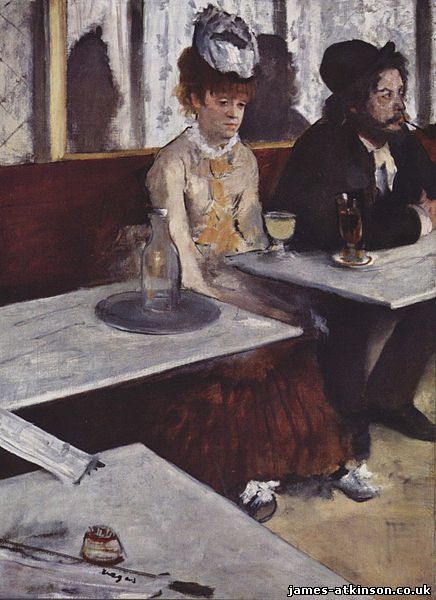 L’Absinthe by Edgar Degas
Van Gogh was an avid drinker. Not only of absinthe but also many other substances too. It is well documented that he had a hereditary mental illness and the bizarre aspects of some of his life have been unfairly blamed on Absinthe. We do know that he very much enjoyed the drink and some have said during this period his work had a slight tint of green (the association has never been proved though). He did try to reduce his Absinthe intake, as evidence is available from letters he wrote at the time. Other well known devotes of the green fairy were Oscar Wilde (writer), Charles Cros (Renaissance man: painter, poet, physicist, chemist, musician and inventor), Charles Baudelaire (one time subversive poet, writer of drama and political novellas and art critic who also consumed large amounts of opium and laudanum – this being his downfall), Paul Marie Verlaine (Poet who was a prolific “La Fee Verte” drinker who eventually drank himself to death), Arthur Rimbaud (poet who was infamous for having a spat with his lover Verlaine. This ended in Verlaine shooting him in the wrist), Guy de Maupassant (the father of the modern short story, known for his efficient prose and style that championed brevity above all), Alfred Jarry (eccentric author who drank absinthe straight!) and of course Ernest Hemingway. Maupassant wrote “A Queer Night in Paris” where he describes sensations caused by the green fairy on the streets of Paris while Hemingway wrote a number of works that featured absinthe. These include ‘For Whom the Bell Tolls’, ‘The Sun Also Rises’ and ‘Hills Like White Elephants’. As an author he is indelibly linked with the absinthe. 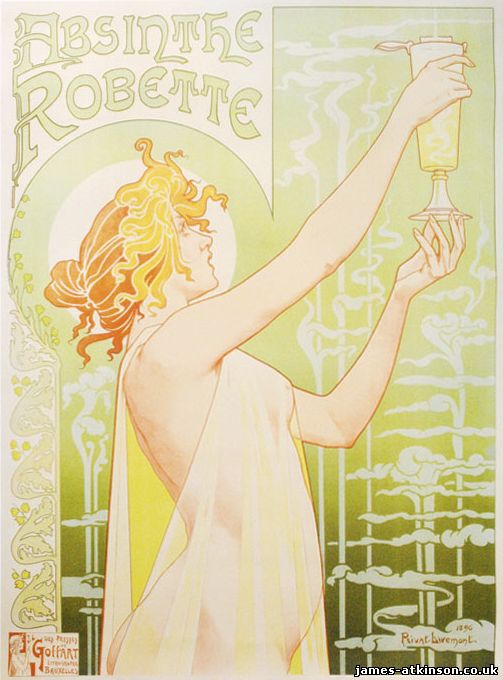 Here is one of the most iconic absinthe Art – Nouveau posters of all
It dates from 1896 by the Belgium artist Henri-Privat-Livemont
Absinthe started to be drunk by all classes of society and in 1874 alone 700,000 litres of absinthe were consumed but in 1910 this exploded to a whopping 36,000,000. The cultural capitals such as Paris and Marseille were where the majority of drinking occurred. To start with it was society ladies and gentleman, artists, politicians, musicians and businessmen. This was soon to change as unscrupulous companies created faux versions of the drink that made its way to lower classes who could not afford the correctly distilled bottles. Suddenly the tide turned and a war was waged on absinthe. It was banned in a number of countries and was led by the anti–alcohol-league and the wine industry. Wine producers thought absinthe ate into their profits, even though wine made up 72% of all drinking in France. A campaign was instigated to discredit absinthe. Suddenly a component of the main constituent in the drink, wormwood, was questioned. Dubious medical science from a leader in his field, Dr. Magnan, stated that a natural occurring active substance in wormwood called thujone was in fact a poison. Thujone is a terpene, which is related to menthol, a healing and restorative ingredient. It is totally natural in white cedar (or Thuja) and even in other herbs apart from just wormwood. These include sage and tansy. Other liquors use small amounts of thujone such as Benedictine and Chartreuse but this was ignored as the anti absinthe league built a case against this tipple that was being blamed on all societies ills. Dr. Magnans used ‘science’ to prove that thujone was dangerous. He used pure alcohol and then thujone oil and gave them to a laboratory rat. Due to the thujone being concentrated the poor rat died. This was proof and was a large part of the case to ban absinthe. Anti-absinthe poster proclaiming, “Absinthe is Death” by F. Monod in 1905
Today we can see the science was incorrect and seems almost estimated. Magnan stated that absinthe contained 250 – 260mg/kg of thujone. This amount came from the average wormwood recipe used in the drink but did not take into account the distillation process. This made the thujone amount much lower and immaterial as a dangerous element. The story leading to the banning of absinthe got even more involved. It became political as the conservative French government wanted to be viewed fighting against bohemian culture and the alcohol abuse of the era. They used low blows as wine production was blighted at the end of the 19th century by oidium and phyloxera. Vineyards had to be destroyed and it was years before production recovered. Add to this the confusion between alcoholism and absinthism, a confusion that was politically fueled. The wine producers and government used the term absinthism as the once natural absinthe had now been cheapened. The original distilleries were still producing the organic drink but unscrupulous organisations were making synthetic versions. They were adding poisonous colourants as the complex green from chlorphylic was replaced by adulterants. Now all members of society were drinking absinthe and this was a gift to the abstinence movement. Now, by the beginning of the 20th century the wheels were in motion to ban the drink. 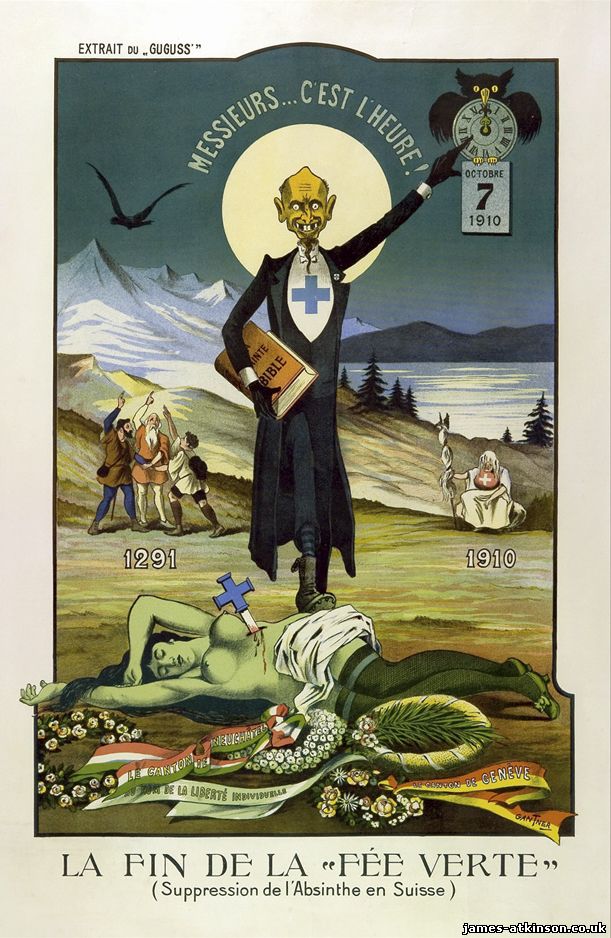 Gantner designed this poster in 1910 to help the ban in Switzerland
It shows a triumphant prohibitionist priest stamping on the Green Fairy In the background we see Helvetia mourning her lost liberties The blue cross was the symbol for the temperance movement against alcohol The final nail in the temperance coffin was the brutal Lanfray murders. The case was infamous as he murdered his own family due to alcohol abuse. He had many types of drink and a very small percentage was absinthe. The trial used this as a ‘classic case of absinthism madness.’ For absinthe it was the end. Public reaction was intense and after the trial 82000 people voted to ban absinthe from Switzerland. Within three months, in May 1906, the Vaud legislature voted to eventually ban absinthe. By October 7th 1910 production, possession and sale of absinthe was illegal in all of Switzerland. Bans followed in Belgium by 1905, USA by 1912 and then finally in France where production went underground. Contrary to popular belief absinthe was never banned in the UK, Denmark and Sweden or in Eastern and Southern Europe such as Spain or Portugal. After the final ban in 1915 the finer producers moved their distilleries over the border to Spain. These included Edouard Pernod and Pernod Fils. A merger followed and Pernod absinthe hit the market, continuing all the way up to 1965. The last disgrace of the French ban was to occur when the remaining stocks of absinthe left in the country after the 1915 ban were sold to buy weapons for the war. That exquisite elixir that once enthralled and inspired a population was converted, by the conservative government of the time, into a source of destruction and violence. 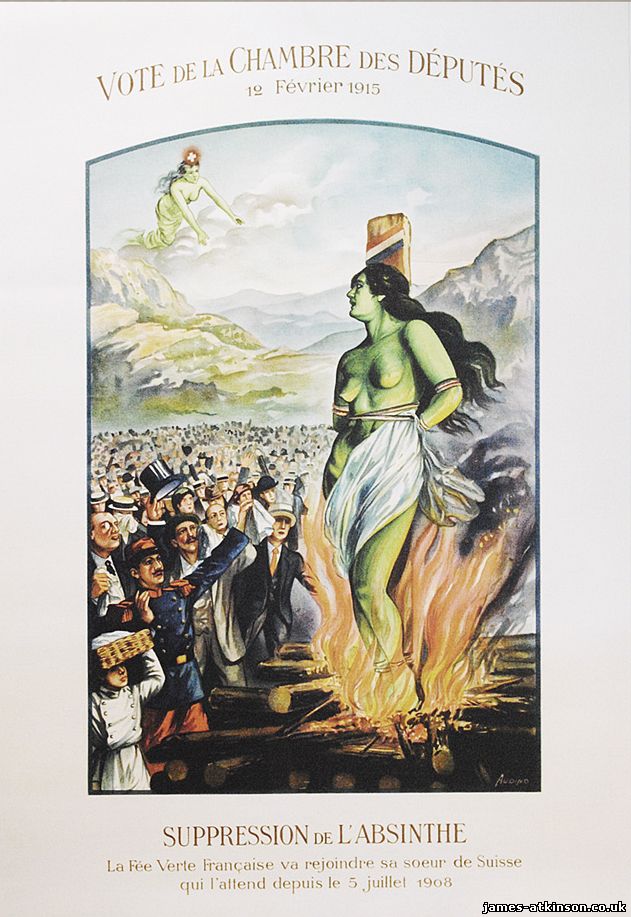 A poster depicting the ban of absinthe by Audino
It is commemorating the law of the French Chamber of Deputies on 12th February 1915 The crowd is sad as the Green Fairy burns and her vision looks up to heaven where her sister from Switzerland has been waiting for seven years
DARK STAR: H. R. GIGER'S WORLD Trailer from Icarus Films on Vimeo. In films absinthe has appeared with variable accuracy. Jude Law seduces Susan Sarandon in Alfie with the help of the ritual but like quite a few movie portrayals it is done via the modern method. This involves burning the sugar cube and alcohol. A technique frowned upon by connoisseurs, as it destroys the taste, and becomes more a visual treat with little reward. The most accurate section in contemporary film is Francis Ford Coppola’s version of Bram Stoker’s Dracula (1992). The scene involved shows Gary Oldman’s ‘Dracula’ tempting of Winona Ryder’s ‘Mina Harker’ via the absinthe ritual. It is very accurate in that the effects can be similar as the herbs produce a visceral plethora of intense sensual delirium. “Absinthe is the aphrodisiac of the self” is a quote that is particularly memorable as an entrance to the sequence.
Van Helsing has a small section showing Kate Beckinsale as ‘Anna Valerious’ taking neat absinthe as a ‘pick me up.’ Hugh Jackman’s ‘Van Helsing’ states “It’s what keeps me going” and Anna takes the bottle from Helsing saying “Here’s what to what keeps you going” Absinthe “strong stuff” is quoted. It certainly would be taken straight, but I suspect there was little time to perform the ritual when chasing vampires!
In 2001 Johnny Depp played the main role in the Hughes Brother’s film ‘From Hell.’ It is fictionally based around the infamous ‘Jack the Ripper’ murders. As Depp’s character ‘Police Inspector Frederick Abberline’ gets more involved in the grisly case, he uses drugs to aid is psychic visions. In the scene below we see Abberline using absinthe to aid produce revelations about the victims. He is seen adding drops of laudanum on the sugar cube. This is a substance containing opium and was a strong narcotic. The sugar would have reduced the bitterness, yet mixing it with absinthe would create a deadly compound. In the film Abberline is seen lighting the sugar and alcohol, implying the flavour was not really the point of consumption……. Johnny Depp - From Hell aka "Tristan's Alcohol... by threemoronstwomics Last but not least is Kylie Minogue in the Baz Luhmann film Moulin Rouge! (2001). Ewan Mcgregor as ‘Christian’ takes in absinthe with his friends and the green fairy emerges as a surreal sequence with Kylie singing while sending Christian off with his friends in to the Parisian nightlife. It is a celebration of the pleasure absinthe can bring.
Moulin Rouge! Absinthe - Kylie Minogue as the Green Fairy Here are some great links; The future looks bright for absinthe.
|
|
|
| Total comments: 2 | |
|
| |
